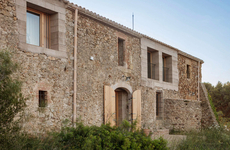
This Contemporary House in the Sawmill Dates to the 18th Century
Elena Rahman — September 8, 2021 — Art & Design
References: homestorming & dezeen
Dubbed the House in the Sawmill, this 18th century sawmill-transformed home was designed by architects André Caetano and Ana Fiúza. The pair converted a former sawmill in the Portuguese town of Oeiras for a young couple looking for a uniquely structured home.
The converted residence sits behind a freestanding gabled wall. It incorporates the 18th-century walls of its predecessor structure into its current architecture. The goal was to preserve these integrated elements, which have become the urban imaginary of this Portuguese town. Three compact patios were introduced into the designed to connect the interior and exterior spaces while allowing natural light to flood the inside. Additionally, the home's entrance is positioned at the base of the gabled wall, creating ample privacy.
Image Credit: André Caetano and Ana Fiúza
The converted residence sits behind a freestanding gabled wall. It incorporates the 18th-century walls of its predecessor structure into its current architecture. The goal was to preserve these integrated elements, which have become the urban imaginary of this Portuguese town. Three compact patios were introduced into the designed to connect the interior and exterior spaces while allowing natural light to flood the inside. Additionally, the home's entrance is positioned at the base of the gabled wall, creating ample privacy.
Image Credit: André Caetano and Ana Fiúza
Trend Themes
1. Sustainable Building - The conversion of the sawmill into a sustainable living space creates an opportunity for builders and architects to design and build more eco-friendly homes.
2. Adaptive Reuse - The transformation of the sawmill into a contemporary residence highlights the potential for adaptive reuse of historical buildings for modern purposes.
3. Integrating Indoor-outdoor Spaces - The incorporation of outdoor patios into the house design reveals a growing trend of homeowners seeking to merge indoor and outdoor living spaces.
Industry Implications
1. Architecture - Architects can develop innovative designs that integrate natural elements and preserve historical structures to create unique living spaces.
2. Construction - Construction companies can specialize in adaptive reuse and sustainable building practices to meet the growing demand for environmentally conscious homes.
3. Real Estate - Real estate developers can explore the potential of adaptive reuse to offer unique residential properties while preserving the historical character of a community.
2.9
Score
Popularity
Activity
Freshness























